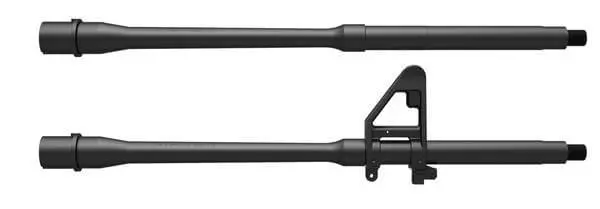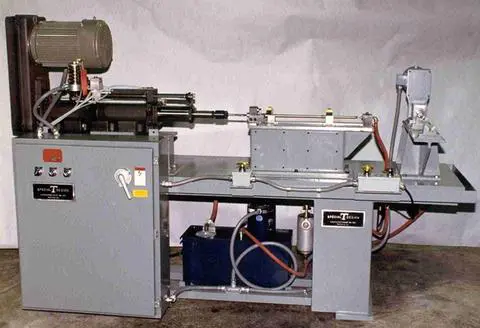
The barrel is the single most important part of the rifle. You can’t build a good rifle around a bad barrel. The AR 15 barrel determines the bullet’s speed and direction when it leaves the muzzle.
This article by Wayne Anderson is part 1 of a 5-part series about AR-15 barrels. The rest of the series can be found at the links below:
Part 2: Barrel Length, Gas Systems, and Rifling
Part 3: Caliber, Chamber, and Steel Types
Part 4: Profiles, Fluting, and Dimpling
Part 5: Surface Treatments and Muzzle Types
AN INTRODUCTION TO AR-15 BARRELS
There are those who will modify that statement, and say, “The most important parts of the AR rifle are the barrel and the bolt carrier group.” But the bolt carrier group can be changed out of the upper in a matter of seconds; the barrel can’t. Yes, the role of the BCG is vital, but choosing the wrong one is easily fixed.
So I’ll say it again: The barrel is the single most important part of the rifle. You can’t build a good rifle around a bad barrel.
Part of the reason is obvious: The barrel determines the bullet’s speed and direction when it leaves the muzzle.
In an AR or other gas-operated weapons, the barrel’s gas system also causes the bolt to cycle, ejecting the spent cartridge, recocking the hammer, feeding a new round into the chamber and locking the bolt in place.
Let’s take a slow-motion walk through exactly what happens.
READY, AIM…
Let’s define a term here because it’ll come up later: Dwell time. This is the time from the moment the primer fires to the moment the bullet leaves the muzzle — the total time the bullet “dwells” in the barrel, and keeps it pressurized. A bullet traveling at 3000 feet per second could clear a 16″ barrel in about 1/2000 of a second. (It’s not precise because there is acceleration time to get to that speed.) We’re going to closely examine what happens in that dwell time.
Step 1: Ignition
When the firing pin strikes the primer on the round, the primer ignites the powder charge behind the bullet. The powder burns at a very fast rate, forming high-pressure gases that cause the shell to stretch against the chamber walls, while forcing the bullet to begin its purpose in life.
Freed from the slightly enlarged shell and kicked in the butt by gases expanding at pressures of 50,000+ pounds per square inch (psi), the bullet leaps across the leader, a very short space before the barrel’s rifling engages the bullet, cuts into its metal jacket, and starts spinning it.
Gunpowder burns very fast, but it doesn’t burn instantly, and it doesn’t burn all at once. Ignition starts at the primer, spreading outward through the powder charge like a shockwave, and burn rate is affected by subtle things like the size and shape of powder grains.
As the bullet travels, the powder behind it is continuing to burn, keeping up the pressure behind it. It has to because the bullet is effectively a cork traveling down the throat of a long pressurized bottle, trapping gases in an ever-expanding pressure chamber. If the pressure didn’t keep building, the bullet would outrun the gases and lose velocity.
In a perfect system, the powder would be 100% consumed at the moment the bullet leaves the muzzle – but the reality is never perfect.
Step 2: Gas Venting
So the powder keeps burning, the gases keep forming, and the pressure keeps up even with the expanded volume. Then something happens: The bullet passes the gas port, a small hole drilled in the top of the barrel, and the dynamics change. The bullet will cover the distance from the gas port to the muzzle in about 1/4000 of a second.
In that time some of the gas pressure is vented upward into the gas port, which allows the expanded shell to contract again, loosening it so it can be extracted. The gas blast races down the gas tube to the gas key on the bolt carrier. The pressure slams the bolt carrier back, unlocking the lugs on the bolt as it rotates out, and the bolt carrier has the rearward momentum it needs to cycle.
Sometime in the same millisecond, the bullet leaves the muzzle, followed by a blast of hot gases and typically some unburned powder. As soon as they’re no longer confined to the tube, the incandescent gases burst forth, traveling at about fifteen times the bullet’s speed and forming something like a bright orange bubble of muzzle flash —
— a bubble that is usually popped by a flash suppressor before it can grow much, cut into a few ribbons of flash. Alternatively, a muzzle brake attached to the barrel could take the impact of the pressurized gases, creating a braking force to counteract the rifle’s recoil. In either case, a compensator might vent some of the gases upward to reduce muzzle climb.
Step 3: Cycling
Meanwhile, the pressure is released, but the bolt carrier has been punched hard, and it’s moving, the extractor taking the spent shell and dragging it to the ejection port. In its travel, the carrier recocks the hammer, and the buffer assembly absorbs its motion, until it bounces off the recoil spring, which drives the bolt forward to strip another round from the magazine and lock it into battery.
And if any of the participants in this pyromechanical choreography don’t play their role, your rifle won’t cycle reliably. Getting it to work right is called “tuning” the rifle. Everything has to be timed to fractions of a thousandth of a second, and that’s not easy.
Fortunately, Eugene Stoner worked out most of the details for us, and generations of smart engineers have built on that. Pretty much all we have to do is use the right parts and follow the instructions.
Fundamentals of AR-15 Barrels
All AR barrels have a few things in common: They’re steel tubes, rifled to spin bullets, and they’re attached to the rifle by the barrel extension, a separate piece joined to the barrel by a qualified gunsmith or factory technician. (That’s not a job you want to take on at home.)
Beyond that, though, there are a lot more variables than you might think. They include: barrel length, gas system length, caliber, chamber dimensions, rifling type and twist rate, type of steel, barrel profile, muzzle type (threaded for a muzzle device, or target crown), surface and bore treatments, and how the barrel itself is created.
And every one of those variables has adherents to one or another choice, and they’ll tell you why their way is the best way. Sometimes cost is a factor, sometimes it isn’t.
In fact, even the barrel extension comes in two flavors: With and without M4-type feed ramps. And since that’s the first thing the round encounters, and one of the simplest to discuss, let’s get it out of the way now.
When the M4 started taking the place of its cousin, the M16, the engineers decided this was their chance to improve it in pretty much every way they could. One of the ideas was to cut two deeper feed ramps into the barrel extension, to eliminate jams where the bullet’s tip would strike at an odd angle and refuse to enter the chamber. It worked, and it still works.
If your barrel extension doesn’t have M4 feed ramps, that doesn’t mean it’s bad. But if you have the choice, unless you’re building a retro clone rifle, get M4 feed ramps.
If we were to follow the bullet’s path through the barrel, then next obvious discussion would be caliber and chambering. But we’ll come back to that later, because it’s complex, and a lot of other factors bear explaining first.
AR-15 Barrel Manufacturing: How Barrels are Created
There are two main ways to create a barrel. The older, and still more common, way is to turn a piece of steel bar stock to the desired diameter and profile, then bore a hole in it with a specialized machine, creating a tube. Rifling is added and the interior is polished. The final few operations (drilling the gas port, threading the muzzle, etc.) are done, and then the barrel is given its surface treatments, if any.
There are a few subtleties in the process, though. From the factory’s perspective, the closer the raw bar stock is to the final dimensions, the better, as it means less machining for each barrel. This is why a lightweight barrel can cost more than a heavier one — it takes more time to remove more material.
Most steel is delivered annealed, which means it’s been heated to a critical temperature, then allowed to cool slowly, leaving it relatively soft. While it’s soft, it’s easier to turn on a lathe, to bore, to cut rifling, etc. Also, if the steel isn’t 100% straight (and we’re talking thousandths of an inch), it should be straightened.
Once all the machining is done, it’s heat treated — heated to a specific temperature, then quenched (cooled suddenly) to harden it to a very specific hardness. We’ve all seen the movies with the blacksmith plunging the orange-hot blade into a bucket of water, then pulling it out dripping and steaming. That was very much a matter of experience and judgement. These days it’s done by machines, with temperatures and times controlled with consistent precision to produce consistent results.
It’s very important that these steps be done in the right order. If a factory were to straighten a completed barrel after heat treating the process would create stresses in the microcrystalline structure of the steel. As such a barrel heats up, it could warp – maybe not visibly, but enough to ruin its accuracy.
In the mid-twentieth century, from the dark heart of Nazi Germany, those Germanic metal-masters invented a new way to create barrels. Hitler was leaning on his armaments industry to produce more and better weapons, and one of the best was the MG34, the world’s best machine gun. The problem was that it demanded a LOT of machining operations, and that meant slow production. When it was redesigned for easier production as the MG42 (which some say can still claim to be the world’s best machine gun), the whole process of making barrels was redesigned with it, because those guns ate barrels almost as fast as they ate ammo.
Cold Hammer Forging
The answer was the cold hammer forging (CHF) technique. It begins with a mandrel, a rod of very hard, very precisely formed steel, an exact negative image of the rifled barrel. The barrel blank is shorter and thicker when it starts – a hole LARGER than the mandrel is bored, and it’s placed over the mandrel.
From that point on immense hydraulic hammers pound the steel blank down around the mandrel, gradually squeezing it like metallic putty until it’s a long, precisely shaped tube — with the rifled mandrel forming the tube. The mandrel is then pulled from the tube, and the new barrel is sent off for finishing operations.
CHF production has its advantages and drawbacks. On the negative side, the machines are tremendously expensive, so your neighborhood gunsmith probably can’t do this for you. In addition, the pounding creates stresses in the steel – but they’re compression stresses, not longitudinal, so they’re unlikely to cause it to bend when it heats up. Also, the beating is more than 416 stainless steel can take, so it’s usually limited to CMV steels, like the 41V45 “Machine Gun Steel” discussed below.
On the plus side, once you have the machine, the process of cranking out barrels is relatively fast and inexpensive. They come out already rifled and work-hardened. And while they’re not always the most accurate barrels you can get, they’re good enough – and some are quite good.
One Last Tip
If there’s anyone that knows the AR-15 platform, it’s the US military. As a special offer for our readers, you can get the Official US Army Manual for AR-15/M4/M16 right now – for free. Click here to snag a copy.







Great info. I’ve assembled a few AR’s for my personal use. After basic training in 71 and my introduction to the M16A1…I was enthralled! A lot of years later….I’m still enthralled! Now I have details!
The biggest problem that I have experienced with my ar’s is trying to determine the proper bullet weight for a specific barrel twist rate. After spending a lot of money and doing a lot of shooting, it seems to me that the 77gr bullet is the best for the 1:7 twist barrel which is what most barrels seem to be these days…I have not had very good luck with the 55 gr and the 62s in the 1:7 twist barrels…anybody else found anything different?
Good read guys, I’m an auto technician and a bit of an amateur gun smith and avid gun enthusiast. Really interesting article from my perspective. Going to read all the articles. Thanks for the insight!
Excellent information, keep it coming. Very believable format, sounds like it is coming from someone who knows. Thank you.
Hello,
Your article are very informative. Great knowledge and article that I enjoy reading. I do have a question if you please. I am interested in building a 300 AAC blockout, and most barrels that I see are in the pistol range, from 8.0-12.5 to which I know is for the most part is to be used with supressors. Say I use a barrel between 10.0 and 12.5 with a supressor, do I have to have a special stock (pistol stock/tube) for the rifle, or can I use a standard 6 position collapable stock that is used on a 14.5 -18.0 inch barrel?
Thank you for your time and info,
Philippe Verbrugghen
Excellent stuff, Guys! Keep up the good work.
Looking forward to the next instalment.
v.